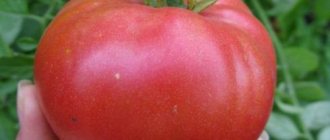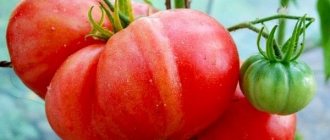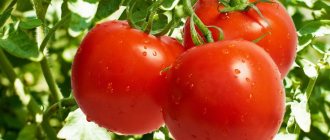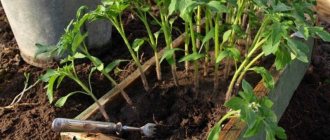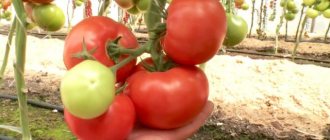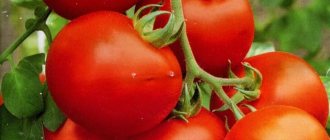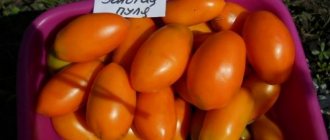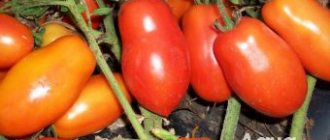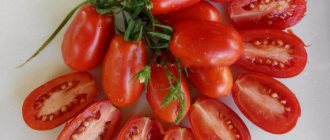The Large Barred Boar tomato is intended for growing in greenhouse conditions in central Russia.
The variety is characterized by good yield, juicy and tasty fruits with an exotic two-color color. The variety was bred in the USA by the famous breeder Brad Grates, but found many fans among domestic vegetable growers.
Peculiarities
The Striped Chocolate tomato variety was developed relatively recently.
It is classified as determinant. The point of completion of growth is determined, as a rule, after six to eight brushes. The bushes are not standard. The roots are quite powerful; rhizome development occurs in a horizontal direction. Stems are stable, weakly leafy. The leaves are medium in size, have a wrinkled surface, are devoid of pubescence, and their color is dark green. The inflorescences are simple, formed above the 8th leaf, then set every 2 leaves. 1 inflorescence can produce up to 5 large tomatoes. Tomato bushes of this variety can reach up to 1.5 m in height. “Striped Chocolate” belongs to the mid-season varieties; fruit ripening occurs on average 95 days from the moment of germination.
Tomatoes are very large in size (diameter up to 15 cm), their weight can reach up to 1 kg, the average weight of one fruit is 500 g. Their shape is round, flattened at the top and bottom. A special feature of this variety is the color of ripe tomatoes. Tomatoes have a burgundy (chocolate) color and numerous stripes of red and dark green. Unripe tomatoes are light green.
The fruits have smooth and dense skin, but it is small in thickness. The pulp has a fleshy consistency, intense color, the number of seeds is small, the maximum number of chambers is 8. The dry matter content is very low. Ripe tomatoes have a sweet taste and a “tomato-like” smell. Children especially like them.
Thanks to their original taste, these tomatoes are ideal for eating raw. They are also used to make pastes, ketchups, sauces, and canned vegetables. In addition, they are widely used as ingredients for hot snacks, but are poorly suited for making tomato juice and for pickling.
Benefits and description of tomato
Those who grow the Great Striped Boar tomato variety note that the fruits of the plant are different:
- rounded shape with slight flattening;
- thin skin;
- color burgundy-brown with green stripes and strokes;
- red juicy pulp;
- sweet taste with a minimum of acid;
- dry matter content 5%;
- weighing 250–400 grams each.
If tomato seeds are purchased from a reliable supplier, then these are the tomatoes the gardener will receive on his plot.
The Great Striped Boar tomato is a rare variety; bred on a private wild boar farm in California specifically for the consumer market. The variety is popular among buyers; characterized by a long fruiting period.
A tomato with an average ripening period begins to bear fruit 100-108 days after germination. The variety is recommended for growing in a greenhouse. During the growing season, the height of the indeterminate type bush reaches 180-200 cm. The leaves are of the usual type.
The formation of the first flower cluster occurs at the level of the 9th leaf, and then at intervals every 3 leaves. An exotic tomato requires tying to a support, shaping, and removing shoots. High productivity is observed when growing a bush with 2 stems.
The variety according to the catalog is defined as bi-color, striped. On a burgundy (dark brown) background there are many stripes and strokes of green with a metallic sheen. The fruits contain up to 5% dry matter.
The fruits have a flat-round, slightly flattened shape. Large fruits have a glossy surface. The pulp is bright red; juicy, sweet in taste. The weight of tomatoes reaches 250-350 g. The yield is 15-18 kg per 1 m².
Reviews from vegetable growers indicate the excellent taste of tomato. California tomatoes are suitable for fresh consumption and for making juice and sauces.
Slices of sweet tomatoes will decorate the holiday table, are suitable as an addition to main courses, and will become the basis of summer dietary salads.
Growing technology
Tomato hybrid 6 Tarasenko
To get a good harvest and grow large and juicy fruits, the crop is planted in open ground using seedlings. Seed preparation is carried out in mid-February. They are soaked in a saline solution to discard seeds that are unsuitable for sowing. All grains that float to the surface must be thrown away. Those that have sunk to the bottom are left behind.
It is necessary to prepare containers with fertile soil. Small holes are made in the ground and the seeds are laid out. They are sprinkled with earth and lightly watered. Seeds should not be buried too deep.
The containers are covered with glass or cellophane. Plantings are placed in a warm place. In about 7-10 days the first shoots will hatch. After they appear, the glass or film is removed and the containers are placed in a sunny place. After the plants have 3 true leaves, pick them. The essence of the method is to plant each plant in a separate container.
During seedling growth, it is necessary to water and fertilize once.
Reviews
This is my second year growing Yellow Striped Boar tomatoes. In the previous year, the yield was low. But I didn’t sin on the variety, because I know that it can really bear a lot of tasty and high-quality fruits. It looks like there were problems with the mineral composition of the soil. This year I took the issue of feeding seriously. So far there is no reason to complain.
The variety is attractive and unusual in appearance. I haven’t grown it in open ground yet, but I plan to do so next year. Tomatoes do not require special care. In general, everything is standard, as for any tall tomato.
Surprised by the resilience of the Yellow Striped Boar. To me, the term “rare” means that the variety needs special care. But this tomato changed my opinion about exotic heat-loving vegetables.
Thanks to my sister who shared the Yellow Striped Boar seeds with me. The wonderful variety coped well with drought and did not show resistance to spot rot, which, fortunately, did not spread.
Characteristics and description of the variety with photos
Tomato "geranium kiss"
The Chocolate Striped tomato was bred by American breeders. In Russia, gardeners began to grow this variety due to its high yields and original color.
This tomato belongs to the indeterminate mid-season varieties.
This variety can be grown both in greenhouse conditions and in open ground. When grown in open ground, it grows up to 1.5 m. If the plant is planted in a greenhouse, the height of the bush can reach 2 meters.
The tomato stem is very strong and thick. There are not very many leaves on the bush. The root system is powerful and grows well in different directions.
Inflorescences on the bushes begin to form above the ninth leaf, and then appear every three leaves. Each inflorescence bears up to 5 - 6 large fruits.
Formation of a bush, usually with one or two stems.
Chocolate striped tomatoes can weigh up to 500-600 grams. But there are also giants that weigh one kilogram. The diameter of the fruit is up to 15 cm. The shape of the tomato is round, slightly flattened at the bottom of the fruit. A distinctive feature of the variety is the presence of bright stripes on the surface of the fruit.
The pulp of tomatoes is dense, juicy, dark in color. Inside each tomato there are eight large seed chambers, with a small number of very large seeds.
A ripe tomato has a red or burgundy color with maroon or dark green stripes that spread evenly over the surface of the fruit. The skin is strong and glossy. The taste of the fruit is sweet, with a slight sourness.
These tomatoes are good to eat fresh for preparing summer salads. This tomato is also suitable for preparing various preparations for the winter.
Opinion about the variety Big Striped Boar
Gardeners appreciated the Californian selection of a vegetable crop - the Great Striped Boar. Reviews praise the sweet taste of the tomato. The unusualness of the fruit in its fluffy skin, consisting of green stripes on a burgundy background, attracts vegetable growers to choose a variety. And the fruits ripen on the bushes in August. They note the juicy fleshy pulp of tomatoes, which are good in salads and slices. Tomatoes are so tasty that they are eaten faster than other tomato varieties.
Features of agricultural technology
Large plantain
Like most nightshade crops, the Chocolate stripes variety is propagated using the seedling method. Sowing material is prepared by the last ten days of February - early March.
- Seeds are checked for germination. To do this, they are soaked in warm water for 10-15 minutes. Those seeds that float to the surface cannot be replanted.
- Special soil is prepared for seedlings. It consists of garden soil, sand and peat, taken in equal parts.
- The seeds are distributed into seedling containers with a density of 2-3 seeds per 1 centimeter. Sprinkle wet peat on top. The containers are covered with film or glass. Greenhouses are placed in a warm place until the first shoots appear.
- After the sprouts appear, the film is removed and the container is placed in a lighted place.
- Fertilizing is carried out on the 15th day after emergence of seedlings with nitrogenous fertilizers. They promote the growth of green mass.
- Seedlings are sensitive to excessive watering. It is produced as needed.
- Given the characteristics of the variety, tomatoes require picking. It is produced at the stage of 2-3 true leaves.
Striped chocolate tomato seedlings are transferred to a permanent place at the age of at least 55-60 days from the moment the first shoots appear. To obtain a high yield, a number of rules are followed.
- Hardening. A week before planting in the ground, the seedlings are hardened off with a decrease in day and night temperatures.
- Landing in the ground. The transfer of seedlings is carried out when the soil has warmed up to 15-16 degrees and night frosts have passed.
- Film protection. When transferred to open beds in the first days, the seedlings are covered with film.
- Choosing a location. Choose a place that is well lit, but without direct sunlight.
- Watering. Watering is carried out as needed in the evening. The next day after watering, loosen the soil.
- Mulching. The ground under the plants is sprinkled with mulch. It serves as a barrier for pests to penetrate seedlings.
- Stepsonning. Striped chocolate tomatoes belong to the tall category. They require stepsoning. The first removal of shoots is carried out 2 weeks after planting in the ground.
- Garter. Plants are tall. Therefore, they need a garter. It is also possible to install trellises.
- Feeding. Fertilization is carried out several times per season. Use complex or nitrogenous fertilizers.
Given the characteristics of tomatoes, in open ground conditions the crop begins to ripen in mid-July. In closed greenhouses, fruiting occurs earlier. It continues until the first days of September.
Features of cultivation
The variety itself and its color can be called a special feature. There is a low availability of this variety in our country. Sowing seedlings for greenhouse cultivation in mid-March, for open ground - mid-April.
The temperature for seed germination should be above 25 degrees. Shoots appear after 6-8 days, while the temperature drops to 20 degrees.
There are a huge number of ways to grow tomato seedlings. We bring to your attention a series of articles on how to do this:
- in twists;
- in two roots;
- in peat tablets;
- without picking;
- using Chinese technology;
- in bottles;
- in peat pots;
- without land.
Planting seedlings in a permanent place in a greenhouse - early May, in open ground - early June. The planting density in the greenhouse is 2 plants per 1 sq.m., in open ground - 3 plants per 1 sq.m.
It needs to be planted in a bright place, but not in direct sun, some shade is needed. Fruiting begins in greenhouse conditions from June, in open ground from July, and ends in September.
Pinching in a greenhouse is recommended; it is necessary to form a plant with 1 stem; pinching is not required in open ground. Pruning is carried out no more than once every 2 weeks; shoots up to 4 cm are removed, otherwise the plant itself can be damaged.
Tying is necessary. Usually vertical trellises or individual stakes are used. The garter material is synthetic only! It does not cause the plant to rot.
There is a good shelf life in a calm state, despite the juiciness. The harvested crop is stored in a dark, dry place.
It is very important to use the correct soil for both seedlings and mature plants in greenhouses. We will tell you about what types of soil for tomatoes exist, how to prepare the right soil yourself, and how to prepare soil in a greenhouse in the spring for planting
We must not forget about such agrotechnical techniques when planting tomatoes as loosening, mulching, and fertilizing.
Growing Striped Chocolate Seedlings
Seeds for planting are prepared in the last week of February or in the first ten days of March. First, they are checked for germination by soaking in water for 10-15 minutes. Unproductive seeds float to the surface of the liquid. They need to be removed. Then the soil is prepared. To create it you will need garden soil, peat and sand. All components are taken in equal proportions.
Seeds are planted in prepared boxes. The planting density is from 2 to 3 seeds per 1 square meter. cm. The seed fund is covered with wet peat on top, and then the boxes are covered with film (a sheet of glass can be used). The containers are placed in a warm room. After 4-8 days, the first shoots will appear. The film is removed, and the boxes are moved under special lamps.
The seedlings are fed 15 days after emergence with fertilizers containing nitrogen. Watering the seedlings is carried out as necessary, since tomatoes of the described type are sensitive to high humidity.
The sprouts sprout after they develop 2-3 leaves. Plants are transplanted into the greenhouse when they are 50-60 days old. Before this, the sprouts are hardened for 10-12 days. If seedlings are transferred to open ground, then to eliminate the risk of seedlings freezing, they are covered with film.
Growing seedlings
In order to get healthy and strong plants that will give a good harvest, in our country tomatoes are grown in seedlings. Seeds are sown in mid-March - early April.
Seed preparation
To speed up the germination of seeds and prevent them from becoming infected with diseases, you need to prepare planting material. Before doing this, make sure that the seeds have not expired.
To select seeds that can germinate, they are soaked in salt water for half an hour. The floating seeds are removed, and those that have settled to the bottom are washed and used for planting.
The seeds need to be disinfected. The most popular way is to soak them in a solution of potassium permanganate for 20 minutes.
Then the planting material is soaked for 12 hours in gauze moistened with warm water. You can use a growth stimulator - this will speed up the germination of tomatoes.
Since the sale of potassium permanganate without a prescription is prohibited, gardeners began to use another method, which involves soaking the seeds for a day in a soda solution. This method allows you to simultaneously disinfect and stimulate the growth of tomatoes.
Soil and container
Choosing the right soil is the key to successfully growing tomatoes.
Soil mixture options:
- Purchased mixtures. In the store you can buy soil mixtures intended for vegetables. They contain all the components necessary for plant growth.
- Prepare the soil yourself. This is the most economical way. The easiest way to prepare soil for tomatoes is to mix turf soil and humus in equal proportions. To make the soil more fertile, you can add sand and ash to the mixture.
- Peat tablets. This is the most convenient, but also the most expensive way to grow tomatoes. Such containers are bags that already contain peat soil with all the necessary fertilizers. When using this method, picking tomatoes is not required.
Purchased and homemade soil must be disinfected. This can be done by calcining it in the oven, pouring boiling water on it, or treating it with a solution of potassium permanganate.
You can take any containers for planting seeds: these can be special boxes, pots, cassettes or homemade containers.
Sowing planting material
The prepared and disinfected container is filled with soil mixture. Seeds are laid on it in rows. The distance between the rows should be 3 cm, and between the seeds - 1.5 cm. The seeds are sprinkled with soil mixture on top.
The container with the seeds is placed in a warm place until the first shoots appear. It needs to be covered with glass or film. If you maintain a temperature of 25 degrees, seedlings will appear a week after sowing the planting material.
The soil needs to be moistened regularly; it is best to do this with a spray bottle as it dries. If the soil becomes waterlogged, you need to remove the film and allow the excess moisture to evaporate.
Rules for caring for seedlings
To get healthy and viable seedlings, you need to follow the following care rules:
- Provide plants with sufficient light. It is best to use a fluorescent or special phytolamp. If it is not there, then the boxes with seedlings should be placed in the brightest part of the room.
- Film or glass will create greenhouse conditions for the seedlings with a high level of humidity. Therefore, even after the first shoots appear, the structure is not immediately dismantled. First, the boxes are aired for several hours a day. After two weeks you can remove the glass.
- It is necessary to water fragile plants under the film so that water does not fall on their above-ground parts. For watering, you can use a syringe or pipette. Once you disassemble the greenhouse, you can start watering the tomatoes in the usual way. The water should be at room temperature. The soil is moistened as it dries.
- When the first true leaves appear, the plants are transplanted into individual pots. When replanting plants, a lump of earth should remain on their roots. One grown tomato needs at least 1 liter of soil. Therefore, gardeners often make two picks, each time using a larger container.
- Seedlings must be prepared in advance for transplanting into the ground. To do this, on warm and sunny days, plants are placed on the windowsill or taken outside. The first time the tomatoes are left in the fresh air for 15-20 minutes, then this time is increased to an hour or two. Gradually, you can begin to take the plants outside for the whole day.
- Seedlings are fed with organic fertilizers. For example, you can use vermicompost. For one plant, take half the indicated dose. The first fertilizing is done in the third week after plant germination. This is then done weekly.
Outdoor care
“Striped chocolate”, in addition to standard care procedures, requires additional measures.
Watering
A high yield is observed in tomatoes when soil moisture is maintained at 75–80%. The top layer of soil should always be moist. It must be remembered that excess water will lead to watery fruits. It is better to use rainwater with a temperature not lower than +20 °C.
The best irrigation option is drip irrigation. To do this, holes are made in the cap of a plastic bottle and the bottom is cut off. Place the tank with the stopper down. As needed, water is poured into the container.
Feeding
The plants are fertilized for the first time 10–12 days after planting on the site. Use rotted manure diluted with water in the proportion of 1 kg/10 l, 2 l/m² at the root. For better absorption of nutrition, fertilizing is combined with watering. If the growth of seedlings is delayed, you need to carry out another similar procedure after 2 weeks.
The second time the crop is fertilized during the formation of inflorescences. Use the same type of fertilizer, reducing the portion of manure to 700 g. Add 1 tbsp to the solution. l. any mineral complex for tomatoes (for example, Kemira) and 3 g of copper sulfate. Watering rate is 2 l/m². During the flowering period, it would be useful to spray with boric acid: ¼ tbsp. l./10 l of water.
The third feeding is carried out during the fruiting period. It is advisable to use complex preparations containing additional minerals in addition to potassium and phosphorus. The drug “Solution” is suitable for this purpose; prepare an aqueous solution in the proportion of 1 tbsp. l./10 l of water. To improve ripening, add 20 g of potassium sulfate to the solution.
Stepsoning
As the green mass grows, you need to regularly pick off the lower leaves, as well as the leaves located close to the fruit clusters. The sections must be sprinkled with crushed activated carbon.
If there are additional shoots in the axils of the inflorescences, they also need to be removed.
Important! During the fruiting period, it is recommended to pinch the tops, thus stopping the growth of the bush, all its strength is spent on the ripening of the fruit.
Soil care
Watering is combined with weeding and loosening the soil. You need to loosen shallowly, about 5 cm, since the roots are located close to the surface.
Tall tomatoes often form adventitious roots close to the soil surface. Therefore, it is advisable to hill them to a height of approximately 7–10 cm. To curb the growth of weeds and retain moisture in the soil longer, the plantings are mulched. Use peat or pine needles, covering the soil with a layer of 5 cm.
Tying up a bush
Tall tomato stems are at risk of breaking from the slightest breath of wind. From the moment of planting, a support is installed for them, followed by a garter. The garter is especially important during the fruiting period: the fruits are heavy and the stems are thin.
For this variety it is convenient to use the trellis method. The ropes, stretched at different intervals on two supports at different ends of the row, allow you to adjust the height of the garter.
Preventative treatment
“Striped chocolate” has strong immunity against most diseases.
A number of measures will help strengthen the protective properties of the plant:
- Maintain crop rotation, do not plant tomatoes in the same place twice.
- Tall bushes need space; plant no more than 3-4 bushes per m².
- Be sure to disinfect planting material and soil.
- Spraying plants with boric acid and copper sulfate will not only provide additional nutrition, but also protect against fungi and viruses.
- Do not overdo it with watering, try not to get it on the foliage and stems. Burns make the plant vulnerable to infections.
- To prevent pests, plant repellent plants (tansy, wormwood, garlic) between rows.
- Pieces of nut shells scattered between the rows will help prevent slugs.
- When diseases appear, use biological fungicides; against pests, use broad-spectrum insecticides.
Care
- An important condition for care is a sufficient amount of sun. Choosing a sunny place on a plot is sometimes easier than in a greenhouse. But it remains an important influencing factor.
- After a week or two, you can begin regular irrigation, delivering water under low pressure to the tomato root system. This can be done using a drip irrigation system. It is impossible to say for sure how often you need to water Yellow Striped Boar plants.
- Farmers should be guided by the dryness of the soil, take into account precipitation, and the drainage capacity of the soil. In a heavy substrate, you need to water less often, while with a light one you will have to supply water weekly, and if necessary, then twice every 14 days.
- In addition, you will have to regularly use fertilizing material in the form of organic matter and a complex mineral product. For active growth of stems before the flowering period, you can apply nitrogen fertilizer once, and then switch to potassium and phosphate. It is a good idea to use compost or humus in small quantities.
- If the farmer does not have the opportunity to fertilize every week, he will have to take care of creating mulch. This will allow nutrients to be slowly delivered to the soil under the bushes. Mulch will simultaneously prevent overheating of the soil in case of heat and take care of controlling moisture evaporation.
Rules for planting, growing and care
In order for the Chocolate Striped Tomato to develop properly and produce a good harvest, it is necessary to follow certain recommendations at all stages of its cultivation. So, the main care procedures are:
- picking;
- weeding;
- loosening;
- watering;
- feeding
Growing and rooting seedlings
You should start preparing planting material from the beginning of March if you plan to grow tomatoes in a greenhouse. When planting a crop in open ground, the preparation procedure can be postponed to April. The initial stage is the preparation of containers and their disinfection.
Next comes checking the seeds. To do this, they are filled with warm water and after 10-15 minutes those that have floated to the surface are removed. The remaining planting material is treated with a weak solution of potassium permanganate.
Planting seeds using the tape method
Tomato seeds are planted in a mixture of peat, river sand and soil in a 1:1:1 ratio. One hole made with a finger will fit 2-3 seeds. The number of holes is calculated based on the area of the container. Then the sowing is covered with a thin layer of peat, polyethylene or cling film. The optimal temperature for germination is +25 °C.
The first shoots appear on day 7-8, after which the room temperature can be reduced to +18 °C and the polyethylene layer can be removed. Diving is carried out when 2-3 true leaves appear on the sprouts.
Transplanting seedlings
The transfer of seedlings to a permanent place occurs from May to June, depending on the planned method of growing tomatoes. Hardening begins 7-10 days before the intended procedure. Containers with young tomatoes are placed outside. At first, their residence time starts from 15-20 minutes, then gradually increases to 24 hours.
The planting site should be well lit, but without direct sunlight. The best option is a plot of land slightly shaded by trees or other plantings.
Growing seedlings in cups
If you plan to grow striped chocolate in open ground conditions, the holes are made at a distance of 50 cm from each other. When growing in greenhouses, it is recommended to increase the distance between them to 60 cm. Per 1 sq. m. plot there are 2-3 bushes in the greenhouse and 4 bushes in the open area. Following these recommendations will allow the tomato to develop properly and will also simplify its care.
Watering and loosening
The frequency of watering tomatoes depends on the amount of precipitation and weather conditions. In cool weather, the planting should be moistened no more than once every 1.5-2 days, and in hot weather the frequency is increased to 1-2 times a day.
Before each watering, to improve air exchange of the soil and deeper penetration of water, the upper layers are loosened.
Feeding
Tomato planting should be fertilized in two stages:
- 1.5 weeks after planting in the ground. At this time, a mixture of potassium humate and urea is suitable for the culture;
- during budding. Monopotassium phosphate is recommended for use. If there is no such component, it can be replaced with superphosphate.
Applying fertilizers to the hole during planting
In addition to mineral fertilizers, organic fertilizers are added to the soil: chicken droppings, manure or nettle infusion. Tomatoes respond well to such fertilizers during the active growth of greenery and the formation of the first ovaries.
Formation of a bush and its garter
If the Striped Chocolate bush grows large, it needs to be tied along the entire length of the main stem. As a support, you should choose reliable structures that can support not only an adult bush, but also a large amount of harvest. The garter is done using soft fabric or loose loops.
Since the variety is indeterminate, it has unlimited growth. If the climate zone suggests a short summer, the top of the bush must be pinched. This procedure allows you to stop the development of the ovaries and direct the plant’s forces to the formation and ripening of the fruits.
Watering
Tomato bushes are especially sensitive to watering. Lack of moisture immediately affects the development of plants, so the humidity level must be monitored regularly. However, it is also not worth watering tomatoes often; it is enough to water them 2 times a week in cloudy weather and 3-4 times in hot periods.
After watering, it is necessary to loosen the soil so that the soil does not become too compacted and the water seeps inside better.
To keep moisture in the ground longer and nourish the plants, you can mulch the ground under the tomatoes. Straw, sawdust or old grass are usually used as mulch. Weeds do not grow under such a layer, and fertilizers and water remain in the soil longer.
In the fall, when the harvest is ripening, it is recommended to free the bushes from their tether and spread them on the ground. These days, watering is not required at all, and the fruits will ripen faster this way.
Recommendations for cultivation
There are some features of growing this variety that will not be difficult for experienced gardeners.
Seedlings and planting in a permanent place
For seedlings, you need to prepare seeds, depending on where you will plant them in a permanent place: if in greenhouse conditions, the seeds are planted in early March, in open beds (in warm regions) - in early April.
Before planting, check the seeds for germination (by soaking them in water for a quarter of an hour). Discard any floating seeds.
- Plant the seeds in the standard way and germinate at a temperature of 23-25°C under a film.
- After the first shoots appear, after about eight days, remove the film and move the future bushes to a bright place and grow at a temperature of 17-18 ° C.
- 2 weeks after the appearance of the first shoots, apply the first fertilizing with nitrogenous fertilizers.
- Planting by transplanting should be done at the stage of 3 true leaves.
- A week before planting in a permanent location, seedlings need to be hardened off in cool temperatures.
- Planting in a permanent place should be done on the 60th day from the moment the first sprouts appear, in places with good lighting, without the threat of frost, in heated soil, placing seedlings 2-3 bushes per 1 m2 according to the scheme: row spacing of 0.5 m, between bushes 0.6 m each.
- Cover the seedlings with film material for the first week.
Care
- Water only when necessary. The next day after moistening, it is good to loosen the soil and it is advisable to mulch the area around the stem - this serves as a good prevention against pests.
- Pinching in a greenhouse is required to form a bush with 1 or 2 stems; in open ground, pinching is not necessary. The frequency of pinching is once every 2 weeks.
- Tying is necessary - since the fruits are large. Tie it with synthetic material to a metal support.
- It is necessary to weed regularly.
- Fertilizing with complex fertilizers for tomatoes must be done at least 2 times per season.
An unusual variety that does not require much care - Yellow Striped Boar tomato: full description
The Yellow Striped Boar tomato is an exotic variety with a sweet, pleasant taste. Collectors and lovers of exotic things will like it, and the simple gardener will be pleased with its delicate, aromatic pulp.
| Height | Landing location | Ripening time | Fruit color | Fruit size | Origin | Fruit shape |
| Tall | Greenhouse, Open ground | Mid-season | Yellow | Average | Variety | Flat-round |
Description and characteristics of the variety
The Yellow Striped Boar tomato variety is the creation of the famous US breeder Brad Gates. The original name sounds like Yellow Striped Boar. The variety is grown in greenhouses or film shelters everywhere except in the southern regions. In the south, tomatoes grow in open ground. Characteristics of the plant: indeterminate bush, about 180 cm high. The foliage is medium, the leaves are ordinary tomato. The ripening period is mid-season. Description of the fruits: medium-sized, flat-round in shape, the weight of the tomatoes differs depending on the planting of the bush and the amount of fertilizing. Usually the fruit weighs 140–200 g. The flesh is rich yellow with marbled reddish stains, the skin is yellow, with thin red stripes. The taste is sweet with sourness, the tomatoes are tasty, juicy, aromatic, and have an exotic flavor. Use in salads, juice is prepared from the fruits or added to various dishes.
- bright beautiful colors;
- rich taste;
- good yield;
- resistance to common diseases.
Minuses:
Landing
Seeds are planted 60–70 days before transferring the bushes to a permanent location. Pre-sowing treatment is carried out: the seeds are soaked for half an hour in a weak solution of potassium permanganate and washed. The solution, only hot, is poured onto the prepared soil.
The soil is laid out in plastic boxes, previously wiped with an antiseptic. Seeds are sown in holes up to 1.5 cm deep. Care:
- After planting, they moisten and provide greenhouse conditions: cover the boxes with film and place them in a warm place.
- When the sprouts appear, transfer to a well-lit and cool place and remove the film.
- The optimal temperature is +16–22.
- They dive into peat pots with the appearance of the second leaf.
They are placed on the site according to a 40 by 60 cm pattern.
Growing and care
The tomato is provided with good lighting, support and pinching. Water under the root with heated water about once every 7 days.
Before flowering, they are fed with nitrogen fertilizer, and then mineral complexes with phosphorus and potassium are added. Loosen the soil.
Diseases and pests
The variety almost does not suffer from cladosporiosis, late blight, and mosaic virus. To protect it from fungi and viruses, follow the following rules of care:
- Weeds are promptly weeded and parasites are controlled.
- Water the bushes moderately, do not overwater them.
- The greenhouse is often ventilated.
- Crop rotation is observed, placing tomatoes in areas after optimal predecessors: cucumbers, zucchini, onions, carrots, cabbage, legumes.
- Disinfect garden pruning tools and greenhouse surfaces.
- Before planting, treat the soil and tomato seeds with a solution of potassium permanganate.
- Plants are sprayed for prevention with a solution of Fitosporin or homemade solutions of fermented milk products.
Treatment with decoctions of garlic, onion or celandine, soap solution or mixtures thereof will help against parasites.
Description of the variety
Having become familiar with the culture and its agricultural technology, gardeners grow “Chocolate Tomato” not only in greenhouses, but also in open areas.
Characteristics and properties of the variety:
- bushes with strong stems grow up to 2 m, dark green foliage is small in size, not pubescent, the root system is horizontal;
- an early development variety, it takes 95–105 days to ripen after planting in open ground;
- Tomato bears fruit in clusters, the first inflorescence is formed above the 7-8 leaf, and about 5 fruits are formed on each cluster;
- on average, the weight of tomatoes is 250–350 g, rounded-oblate shape, dark red color with a bronze tint, with dark green stripes along the edges;
- the fruit has a thick skin that can withstand long-term transportation;
- the pulp is dense, juicy, sickly sweet in taste, there are 8–10 chambers with seeds;
- The variety is characterized by long-term fruiting and resistance to infections of nightshade plants.
Diseases and pests
Expert opinion
Valentina Rareko
Editor-in-Chief of Repka.online. Experienced summer resident and gardener.
The Yellow Striped Boar tomato is an excellent variety with fleshy, juicy and tasty pulp that will become the pearl of any salad.
Reviews from those who grew 0″ > Order by:Most recentTop scoreMost helpfulWorst score
Vika09/06/2019, 10:53
Verified
City: ShostkaWhere grown: Open groundProducer: Selection seeds
Show more
You can prevent the spread of pests by regularly weeding the garden beds. Next to tomatoes, you can plant reliable “plant companions” in the form of marigolds, which help keep insect infestation under control.
Among various tomato diseases, the Yellow Striped Boar tomato variety is not afraid of late blight, cladosporiosis, and tobacco mosaic. It is better to prevent other diseases by regular watering and proper fertilizing, as well as timely removal of damaged parts of the plant.
Description of the variety
On average, the weight of a tomato is 500-600 grams. The fruit pulp is darkish, fleshy, with a small amount of seeds, very sweet. This variety is suitable for salad and canning purposes; however, it is not suitable for juices and whole fruit marinades and is prone to cracking when exposed to temperature.
Pros:
- Has sufficient resistance to pests and diseases;
- Possibility of long-term fruiting;
- Unusual taste and aroma;
- The fruits have a marketable appearance due to their skin color;
- Highly productive.
Flaws:
- In hot weather, the fruits crack and rot;
- The plant requires a garter to a strong support;
- Difficulties with transportation.
Chocolate tomato: description of the variety and cultivation characteristics
One of the popular dark-fruited tomato varieties was developed by the Russian agricultural company Aelita. The variety is mid-season, semi-determinate, 110-150 cm high. 110-115 days pass from germination to fruit ripening. They begin to plant seedlings from the end of May. The leaves of the stem are dark green. The fruits have a beautiful brown-red color, with brownish fleshy pulp. The weight of the fruit reaches 200-400 g.
Most often, chocolate tomatoes are grown in greenhouses. But even in open ground the variety gives good results. In greenhouses it is easier to protect plants from pests and atmospheric surprises.
Chocolate tomatoes are well suited for preparing various dishes, such as salads
Chocolate tomato is used everywhere:
- In slices, salads.;
- The variety is perfect for canning, both in whole and processed form;
- Can be used to make juices.
The taste and uses are varied. The taste of Chocolate variety tomatoes can be described as sweet. Most often, tomatoes of this type are used in the preparation of fresh salads. They cannot be stored for a long time, so tomatoes should be used immediately after picking from the site, avoiding lying for a long time, especially in the sun.
In general, quite a lot of varieties of black-fruited tomatoes have been developed. There are Russian and foreign developments. You can choose greenhouse varieties; there are also tomatoes for planting in the ground. In addition to the listed varieties, we can recommend for planting some varieties that were not described above - Black Prince, Black Pineapple, Chocolate Cream, Gypsy, Black Elephant, Negritenok, Paul Robeson and Black Gourmet, Chocolate. With proper care, all of the listed varieties produce beautiful, sweet fruits of amazing color. In addition, black tomatoes are recommended for children's and dietary nutrition.
Tiger tomatoes: Striped varieties with a twist
When a summer cottage is a favorite hobby, growing crops turns into creativity that has no boundaries. I want to plant the most unusual varieties and plants on my plot! To nurture and cherish, to admire how they grow and to reap an unprecedented harvest... And many varieties “with a twist” have already been bred. For example, striped tomatoes. A sort of tiger cubs that warm their sides in cozy greenhouses and delight not only the eye, but also the taste buds. We present to your attention a selection of “striped” tomato varieties.
Tomato “Lemon Sparkle”
Series: Oriental delicacy
Photo of the variety:
Description and characteristics:
These minke whales have very interesting and tasty fruits that are good both fresh and canned. The variety is mid-season: 100-115 days pass from the emergence of seedlings to ripening. Suitable for growing in open ground and film greenhouses. Indeterminate type. Produces plants up to 1.5-2 m high. Average fruit weight: 60-100 g.
Label:
Tomato variety “Non-grassing striped”
Series: Nepas
Photo of the variety:
Description:
- Early ripening variety (from germination to ripening: 95-100 days).
- Determinant type.
- Forms a plant 60-70 cm high.
- Suitable for growing in open ground and under film cover.
- Does not require pinching, as the name itself suggests.
- The tomatoes are oval-shaped, raspberry-colored with elegant orange stripes.
- Average fruit weight: 70-80 g.
- Productivity is high.
- Good for winter preparations in whole form.
Variety "Striped flight"
Photo of the variety:
Characteristics:
- Determinant type.
- Very decorative, great for canning whole fruits.
- Average fruit weight: only 30-40 g.
- Dense, elastic, tasty pulp.
- Requires stepsoning.
Planting and care
For sowing, purchase a ready-made substrate or prepare a mixture based on turf. For fertility, add to the soil:
- compost,
- peat,
- sand.
Planting period is from the end of February to the end of March.
Tomato seeds have good germination.
To speed up germination, modern activators “Kornevin” and “Zircon” are used.
Secrets of caring for seedlings:
- Lighting with phytolamps.
- Irrigation with warm water.
- Watering with Kemira.
- Picking in a 0.3 liter container with 2-3 true leaves.
Recommended tomato varieties
Alina User rating: 4/5
Persimmon NK User rating: 5/5
Diva F1 User rating: 4.7/5
Pink Pioneer F1 User rating: 5/5
Specifics of growing tomato
To grow fruiting tomato bushes of the Striped Chocolate variety, they begin with preparing and sowing seeds and caring for seedlings. After transplanting the strengthened seedlings to a permanent place, a standard set of agrotechnical works is performed.
Planting and caring for seedlings
Sowing dates are determined by calculation. Seeds are planted in the soil no earlier than 55 days before planting in open ground:
- in the south of Russia - at the end of February–beginning of March;
- in the Central region - from mid to late March;
- in Siberia and the Urals - April 1–15.
The dates are shifted back two weeks if it is planned to transplant Striped Chocolate tomato seedlings into a greenhouse.
The seed in a canvas bag is dipped for 30 minutes in a 5% soda or weak manganese solution for half an hour. After disinfection, the seeds are kept in a growth stimulant for 2 hours - Kornevin, Zircon, aloe juice.
To speed up germination, Striped Chocolate tomato seeds are soaked until they swell. Place wet gauze at one end on a saucer, distribute the seeds evenly on top, and cover with a free corner of the cloth. Leave in a warm place for 12 hours.
Next, drainage holes are made in the container or plastic cups, and a layer of expanded clay is placed on the bottom. The next step is to fill the container with a soil mixture of equal parts of peat, river sand, and turf soil. Add 2 parts of humus and ash at the rate of 1 tbsp. l. per 1 kg of substrate. You can use pre-soaked peat tablets.
Sowing begins by moistening the soil, creating furrows 1 cm deep. When planting tomato seeds, maintain a distance of 1-2 cm between them, and 3-4 cm between rows. Sprinkle soil on top. Until the Striped Chocolate tomatoes sprout, maintain the air temperature at 23-25°C.
If crops are covered with film or glass, daily ventilation is necessary to prevent condensation from accumulating and mold to grow. The shelter is removed on the 5-8th day after seed germination, the temperature is reduced to 14-18°C.
For a full growing season, tomato seedlings need 12 hours of daylight. If conditions are not appropriate, use lamps for additional lighting. Moisten the soil as it dries. Picking is carried out at the stage of appearance of 2-3 true leaves.
The intensity of watering is increased several days before transplanting tomatoes. To avoid bending of the stems, turn the container with the plants with the opposite side towards the sun every other day.
Transfer
Striped chocolate tomatoes are planted in the garden when the soil warms up to 16°C and the threat of frost has passed. In order for the seedlings to take root faster, the plants are hardened off a week before the event, taking the container out to the balcony or street every day.
Tomatoes prefer sunny areas with slightly acidic, loose soil, permeable to oxygen and moisture. Tomatoes react poorly to direct sunlight and drafts.
Seedlings are planted in open ground, maintaining a distance between holes of 0.5 m, a row spacing of 0.7 m. In a greenhouse, more free space is left between plants in the row - 0.6 m. The depth of the planting hole depends on the development of the root system.
At the end of the event, Striped Chocolate tomatoes are watered and mulched with hay, peat or sawdust. Mulch reduces the intensity of watering, the amount of weeding, and prevents attacks by pests overwintering in the ground.
During the first few days, for better rooting of seedlings in open ground, it is recommended to stretch a film secured to iron arches over the plantings. Another option is to cover the plants with agrofibre at night.
